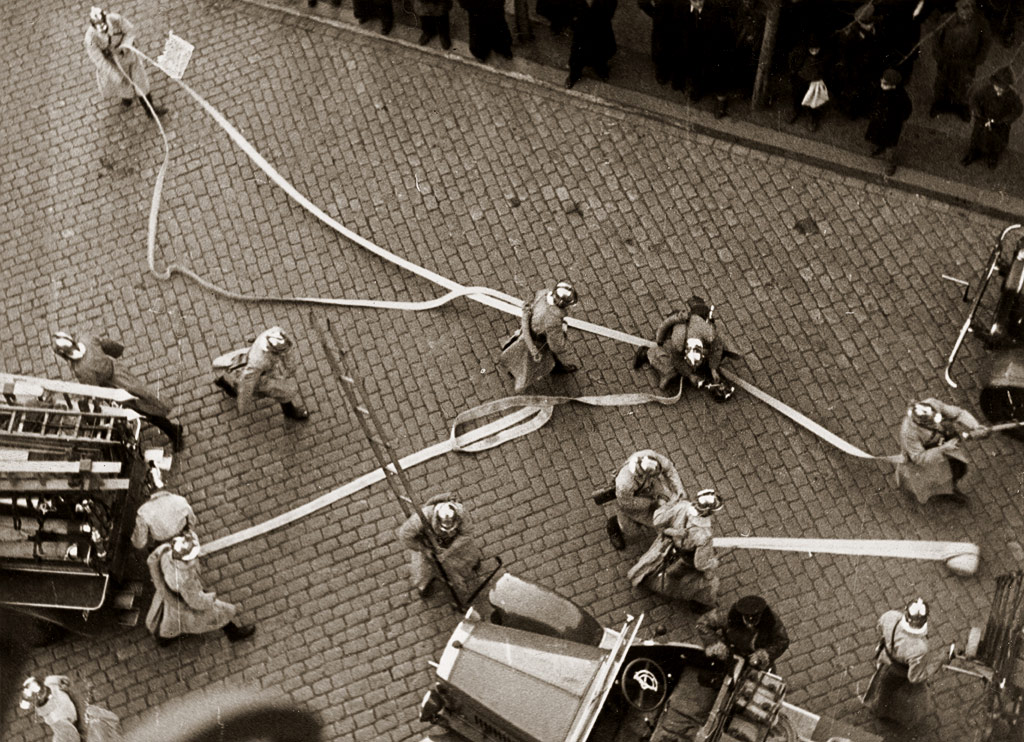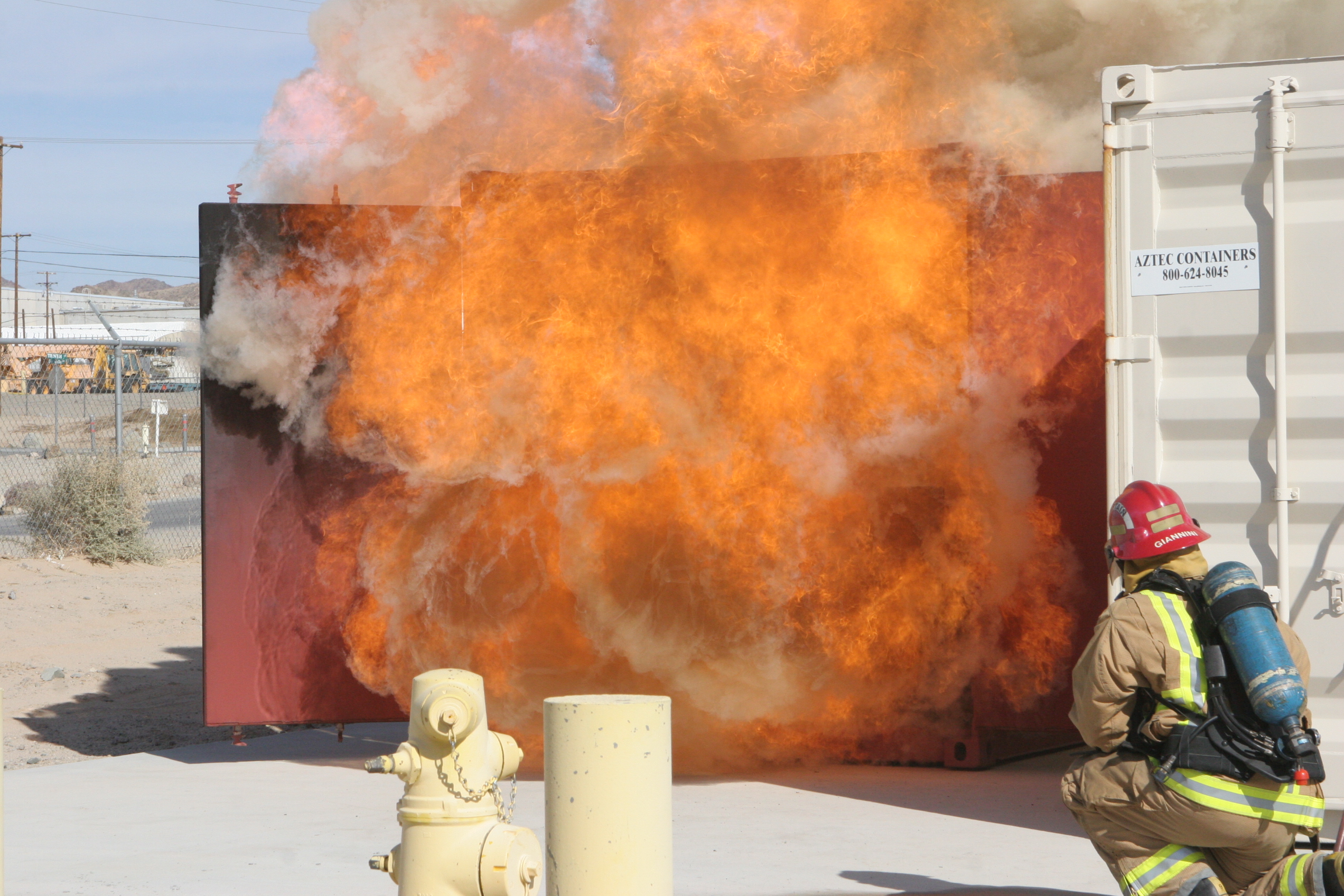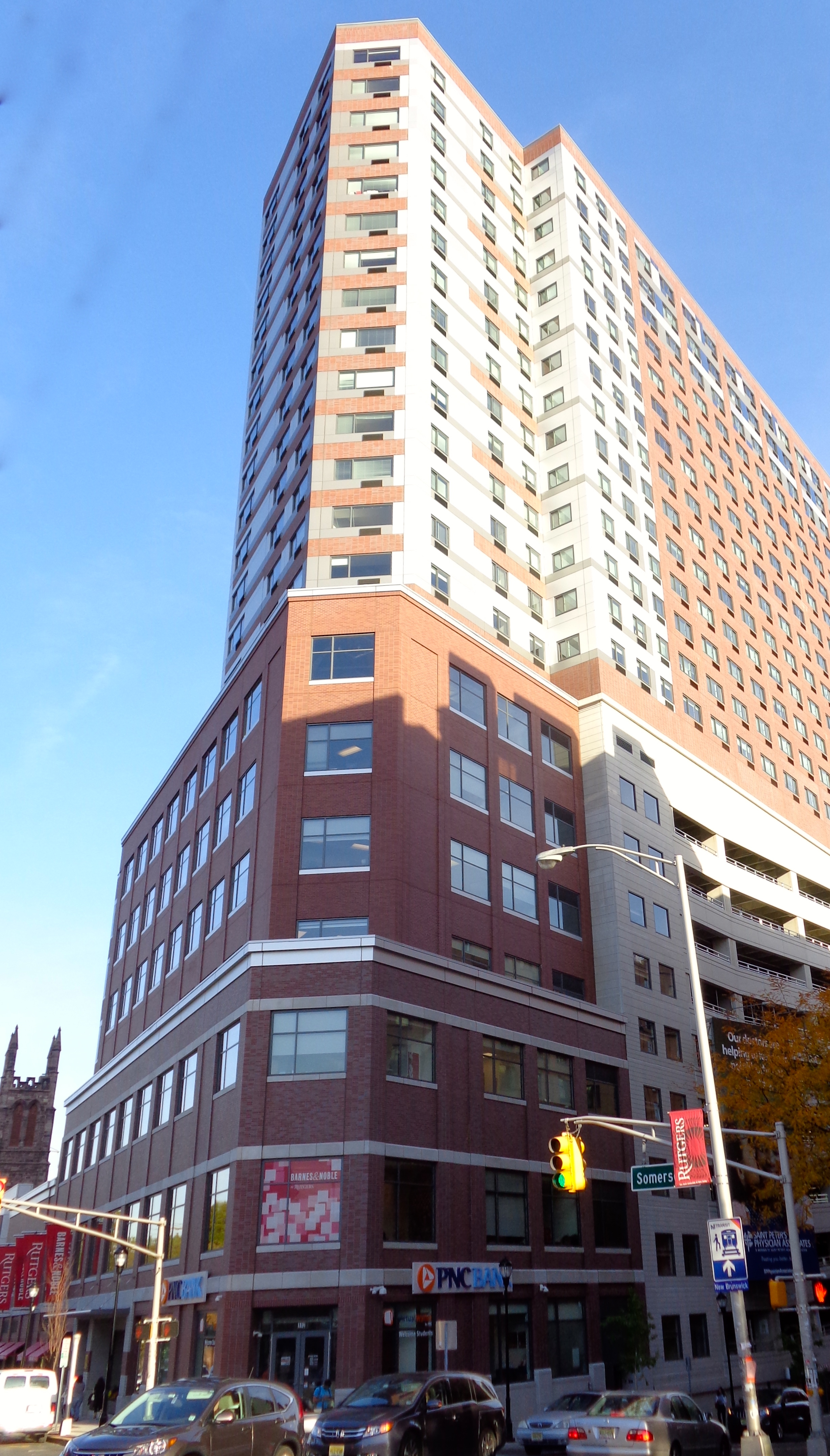|
Ventilation (firefighting)
Ventilation is a part of structural firefighting tactics, and involves the expulsion of heat and smoke from a burning building, permitting the firefighters to more easily and safely find trapped individuals and attack the fire. If a large fire is not properly ventilated, it is much harder to fight, and can build up enough poorly burned smoke to create a smoke explosion or enough heat to create a flashover. Poorly placed or timed ventilation can increase the fire's air supply, causing it to grow and spread rapidly. Flashover from inadequate ventilation can cause the temperature inside the building to peak at over . Types of ventilation In general, there are two types of ventilation; vertical and horizontal. Their names refer to the general locations of the intended exit points of the heat and smoke to be ventilated. Vertical ventilation takes place through holes cut in the roof, typically by truck companies during the early stages of a fire in a process known collectively as roo ... [...More Info...] [...Related Items...] OR: [Wikipedia] [Google] [Baidu] |
Firefighting
Firefighting is the act of extinguishing or preventing the spread of unwanted fires from threatening human lives and destroying property and the environment. A person who engages in firefighting is known as a firefighter. Firefighters typically undergo a high degree of technical training. This involves structural firefighting and wildland firefighting. Specialized training includes aircraft firefighting, shipboard firefighting, aerial firefighting, maritime firefighting, and proximity firefighting. Firefighting is a dangerous profession due to the toxic environment created by combustible materials, with major risks are smoke, oxygen deficiency, elevated temperatures, poisonous atmospheres, and violent air flows. To combat some of these risks, firefighters carry self-contained breathing apparatus. Additional hazards include falls — a constant peril while navigating unfamiliar layouts or confined spaces amid shifting debris under limited visibility – and structural collaps ... [...More Info...] [...Related Items...] OR: [Wikipedia] [Google] [Baidu] |
Smoke Explosion
A backdraft (North American English) or backdraught (British English) is the abrupt burning of superheated gasses in a fire, caused when oxygen rapidly enters a hot, oxygen-depleted environment; for example, when a window or door to an enclosed space is opened or broken. Backdrafts present a serious threat to firefighters. There is some debate concerning whether backdrafts should be considered a type of flashover (see below). Burning When material is heated enough, it begins to break down into smaller compounds, including hydrogen. This is called pyrolysis, and does not require oxygen. If oxygen is also provided, then the hydrogen can combust, starting a fire. If material undergoing pyrolysis is later given sufficient oxygen, the hydrogen gas will ignite, and therefore, combustion takes place. Cause A backdraft can occur when a compartment fire has little or no ventilation. Due to this, little or no oxygen can flow into the compartment. Then, because fires reduce oxygen, th ... [...More Info...] [...Related Items...] OR: [Wikipedia] [Google] [Baidu] |
Flashover
A flashover is the near-simultaneous ignition of most of the directly exposed combustible material in an enclosed area. When certain organic materials are heated, they undergo thermal decomposition and release flammable gases. Flashover occurs when the majority of the exposed surfaces in a space are heated to their autoignition temperature and emit flammable gases (see also flash point). Flashover normally occurs at or for ordinary combustibles and an incident heat flux at floor level of . An example of flashover is the ignition of a piece of furniture in a domestic room. The fire involving the initial piece of furniture can produce a layer of hot smoke, which spreads across the ceiling in the room. The hot buoyant smoke layer grows in depth, as it is bounded by the walls of the room. The radiated heat from this layer heats the surfaces of the directly exposed combustible materials in the room, causing them to give off flammable gases, via pyrolysis. When the temperatures of th ... [...More Info...] [...Related Items...] OR: [Wikipedia] [Google] [Baidu] |
Ladder Truck
A fire engine (also known in some places as a fire truck or fire lorry) is a road vehicle (usually a truck) that functions as a firefighting apparatus. The primary purposes of a fire engine include transporting firefighters and water to an incident as well as carrying equipment for firefighting operations. Some fire engines have specialized functions, such as wildfire suppression and aircraft rescue and firefighting, and may also carry equipment for technical rescue. Many fire engines are based on commercial vehicle chassis that are further upgraded and customised for firefighting requirements. They are normally fitted with sirens and emergency vehicle lighting, as well as communication equipment such as two-way radios and mobile computer technology. The terms ''fire engine'' and ''fire truck'' are often used interchangeably to a broad range of vehicles involved in firefighting; however, in some fire departments they refer to separate and specific types of vehicle. Design ... [...More Info...] [...Related Items...] OR: [Wikipedia] [Google] [Baidu] |
20191211Compartment Fire Behavior Training And Tactical Ventilation Instructor International Course IMG 8560
Year 191 ( CXCI) was a common year starting on Friday (link will display the full calendar) of the Julian calendar. At the time, it was known as the Year of the Consulship of Apronianus and Bradua (or, less frequently, year 944 ''Ab urbe condita''). The denomination 191 for this year has been used since the early medieval period, when the Anno Domini calendar era became the prevalent method in Europe for naming years. Events By place Parthia * King Vologases IV of Parthia dies after a 44-year reign, and is succeeded by his son Vologases V. China * A coalition of Chinese warlords from the east of Hangu Pass launches a punitive campaign against the warlord Dong Zhuo, who seized control of the central government in 189, and held the figurehead Emperor Xian hostage. After suffering some defeats against the coalition forces, Dong Zhuo forcefully relocates the imperial capital from Luoyang to Chang'an. Before leaving, Dong Zhuo orders his troops to loot the tombs of the H ... [...More Info...] [...Related Items...] OR: [Wikipedia] [Google] [Baidu] |
Mechanical Fans
A fan is a powered machine used to create a flow of air. A fan consists of a rotating arrangement of vanes or blades, generally made of wood, plastic, or metal, which act on the air. The rotating assembly of blades and hub is known as an ''impeller'', ''rotor'', or ''runner''. Usually, it is contained within some form of housing, or case. This may direct the airflow, or increase safety by preventing objects from contacting the fan blades. Most fans are powered by electric motors, but other sources of power may be used, including hydraulic motors, handcranks, and internal combustion engines. Mechanically, a fan can be any revolving vane, or vanes used for producing currents of air. Fans produce air flows with high volume and low pressure (although higher than ambient pressure), as opposed to compressors which produce high pressures at a comparatively low volume. A fan blade will often rotate when exposed to an air-fluid stream, and devices that take advantage of this, such a ... [...More Info...] [...Related Items...] OR: [Wikipedia] [Google] [Baidu] |
Window
A window is an opening in a wall, door, roof, or vehicle that allows the exchange of light and may also allow the passage of sound and sometimes air. Modern windows are usually glazed or covered in some other transparent or translucent material, a sash set in a frame in the opening; the sash and frame are also referred to as a window. Many glazed windows may be opened, to allow ventilation, or closed, to exclude inclement weather. Windows may have a latch or similar mechanism to lock the window shut or to hold it open by various amounts. In addition to this, many modern day windows may have a window screen or mesh, often made of aluminum or fibreglass, to keep bugs out when the window is opened. Types include the eyebrow window, fixed windows, hexagonal windows, single-hung, and double-hung sash windows, horizontal sliding sash windows, casement windows, awning windows, hopper windows, tilt, and slide windows (often door-sized), tilt and turn windows, transom windo ... [...More Info...] [...Related Items...] OR: [Wikipedia] [Google] [Baidu] |
Skylight (window)
A skylight (sometimes called a rooflight) is a light-permitting structure or window, usually made of transparent or translucent glass, that forms all or part of the roof space of a building for daylighting and ventilation purposes. History Open skylights were used in Ancient Roman architecture, such as the oculus of the Pantheon. Glazed 'closed' skylights have been in use since the Industrial Revolution made advances in glass production manufacturing. Mass production units since the mid-20th century have brought skylights to many uses and contexts. Energy conservation has brought new motivation, design innovation, transmission options, and efficiency rating systems for skylights. Prior to the Industrial Revolution, it was Spain and France that probably had the leading technology in architectural glass. One of the earliest forms of glass skylight can be seen at the Burgos Cathedral in the Chapel of the Constable. Other early form of glass skylight can be seen at the Palace of ... [...More Info...] [...Related Items...] OR: [Wikipedia] [Google] [Baidu] |
High-rise Building
A tower block, high-rise, apartment tower, residential tower, apartment block, block of flats, or office tower is a tall building, as opposed to a low-rise building and is defined differently in terms of height depending on the jurisdiction. It is used as a residential, office building, or other functions including hotel, retail, or with multiple purposes combined. Residential high-rise buildings are also known in some varieties of English, such as British English, as tower blocks and may be referred to as MDUs, standing for multi-dwelling units. A very tall high-rise building is referred to as a skyscraper. High-rise buildings became possible to construct with the invention of the elevator (lift) and with less expensive, more abundant building materials. The materials used for the structural system of high-rise buildings are reinforced concrete and steel. Most North American-style skyscrapers have a steel frame, while residential blocks are usually constructed of con ... [...More Info...] [...Related Items...] OR: [Wikipedia] [Google] [Baidu] |
Positive Pressure
Positive pressure is a pressure within a system that is greater than the environment that surrounds that system. Consequently, if there is any leak from the positively pressured system it will egress into the surrounding environment. This is in contrast to a negative pressure room, where air is sucked in. Use is also made of positive pressure to ensure there is no ingress of the environment into a supposed closed system. A typical example of the use of positive pressure is the location of a habitat in an area where there may exist flammable gases such as found on an oil platform or laboratory cleanroom. This kind of positive pressure is also used in operating theaters and ''in vitro'' fertilisation (IVF) labs. Hospitals may have positive pressure rooms for patients with compromised immune systems. Air will flow out of the room instead of in, so that any airborne microorganisms (e.g., bacteria) that may infect the patient are kept away. This process is important in human and ... [...More Info...] [...Related Items...] OR: [Wikipedia] [Google] [Baidu] |
Glossary Of Firefighting
: ''Note: This list does not include firefighting equipment, i.e., tools and apparatus used by firefighters. Please refer to Glossary of firefighting equipment for such terms. Similarly, although there is much overlap, you may also want to refer to the Glossary of wildfire terms for terminology particular to that type of firefighting.'' : ''Note: Many of the terms defined here, particularly relating to systems of work, team names, procedures, careers and policies, seem to originate in the U.S. and are not necessarily applicable to other English-speaking countries' fire and rescue services. For example, ''Call Firefighter'' (U.S.) and ''Retained Firefighter'' (UK). Firefighting jargon includes a diverse lexicon of both common and idiosyncratic terms. One problem that exists in trying to create a list such as this is that much of the terminology used by a particular department is specifically defined in their particular standing operating procedures, such that two departments may hav ... [...More Info...] [...Related Items...] OR: [Wikipedia] [Google] [Baidu] |





.jpg)

